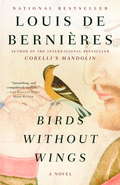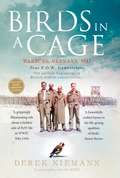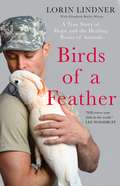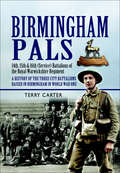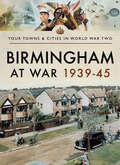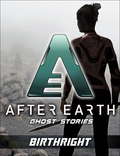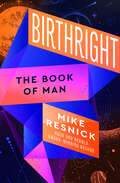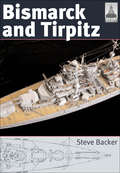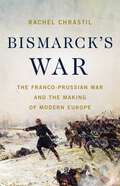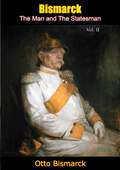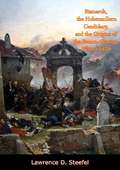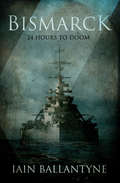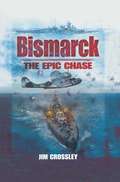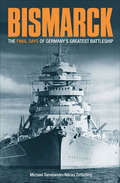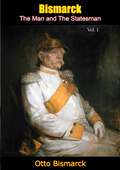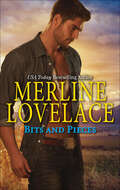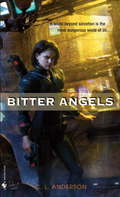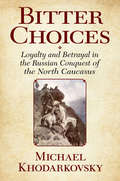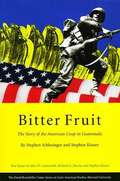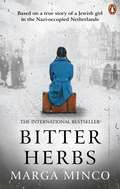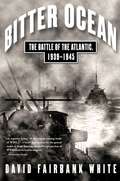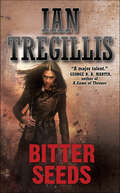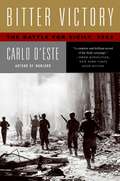- Table View
- List View
Birds Without Wings
by Louis De BernieresIn his first novel since Corelli's Mandolin, Louis de Bernières creates a world, populates it with characters as real as our best friends, and launches it into the maelstrom of twentieth-century history. The setting is a small village in southwestern Anatolia in the waning years of the Ottoman Empire. Everyone there speaks Turkish, though they write it in Greek letters. It's a place that has room for a professional blasphemer; where a brokenhearted aga finds solace in the arms of a Circassian courtesan who isn't Circassian at all; where a beautiful Christian girl named Philothei is engaged to a Muslim boy named Ibrahim. But all of this will change when Turkey enters the modern world. Epic in sweep, intoxicating in its sensual detail, Birds Without Wings is an enchantment.From the Trade Paperback edition.
Birds in a Cage: Warburg, Germany, 1941- Four P. O. W. Birdwatchers - The Unlikely Beginning Of British Wildlife Conservation...
by Derek NiemannThis is the inspiring true story of how a passion for birds enabled four young men to escape the horror of internment in a German PoW camp... and brought about an extraordinary moment of cooperation and mutual understanding between them and their captors. Soon after their incarceration at Warburg in 1941, Peter Conder, John Buxton, John Barrett and George Waterston discovered a shared love of birdwatching. Before long, their obsessive quest for information on the nesting habits of chaffinches, redstarts and others took over the whole camp - including some of the German guards, who began to assist the PoWs in their observations at great risk to their own lives. In this tender, revelatory book, Derek Niemann draws on original diaries, letters and drawings, as well as the memories of those...
Birds of a Feather: A True Story of Hope and the Healing Power of Animals
by Lorin Lindner"This true story will twist your heart like a sponge and renew your faith in the world." —Lee Woodruff, co-author with Bob Woodruff of the New York Times bestseller In an Instant "A heartwarming book." —Vicki Myron, author of New York Times #1 Bestseller Dewey"Reminds us of the extraordinary ways caring people are helping the men and women who have served our country...and animals along with them." —Maxine Waters "I defy anyone to read it without shedding tears." —Rosemary Low, author of The Complete Book of Parrots"It left me smiling, full of hope, and wishing there were more Lorin Linders out there." —Mary GauthierAnimal lover though she was, Lorin Lindner was definitely not looking for a pet. Then came Sammy – a mischievous and extremely loud bright pink Moluccan cockatoo who had been abandoned. It was love at first sight. But Sammy needed a companion. Enter Mango, lover of humans ("Hewwo"), inveterate thief of precious objects. Realizing that there were many parrots in need of new homes, Dr. Lindner eventually founded a sanctuary for them.Meanwhile, she began to meet homeless veterans on the streets of Los Angeles. Before long she was a full time advocate for these former service members, who were often suffering from Post-Traumatic Stress Disorder (PTSD). Ultimately, Dr. Lindner created a program for them, too.Eventually the two parts of her life came together when she founded Serenity Park, a unique sanctuary on the grounds of the Greater Los Angeles Veterans Administration Healthcare Center. She had noticed that the veterans she treated as a clinical psychologist and the parrots she had taken in as a rescuer quickly formed bonds. Men and women who had been silent in therapy would share their stories and their feelings more easily with animals. Birds of a Feather is ultimately a love story between veterans and the birds they nurse back to health and between Dr. Lindner and her husband, a veteran with PTSD, who healed at Serenity Park. Full of remarkable people and colorful birds, this book reminds us that we all have the power to make a difference.
Birmingham Pals: 14th, 15th & 16th (Service) Battalions of the Royal Warwickshire Regiment, A History of the Three City Battalions Raised in Birmingham in World War One (Pals Ser.)
by Terry CarterIn the summer of 1914, our finest young men flocked to the colors in Northern towns and cities to answer Lord Kitcheners Call to Arms in a spontaneous burst of enthusiasm and patriotism. The Call appealed to their sense of adventure and offered an escape from the humdrum life of office, factory and mill.The new recruits volunteered with brothers, cousins, friends and work mates. The newly formed units became the focus of local civic pride and soon became known as the Pals. The City of Birmingham formed three such battalions with over 3,000 local volunteers. This book tells their story.Birmingham Pals is a story that covers the full range of human experience in war—the highest courage and bravery, the misery and tedium of trench life, the exhilaration, terror and slaughter involved in going over the top. Above all, it is a story of interest to people of all backgrounds and ages, as a tale of comradeship, which, for many survivors, was to last a life time.
Birmingham at War, 1939–45 (Your Towns & Cities in World War Two)
by Julie PhillipsBarely 17 years after the Great War that had brought Britain to its knees, the country was once again asked to make sacrifices and give their all to the war effort. With its strong industrial background, Birmingham was already geared to help manufacture the vehicles that could be adapted for war use, and with the threat of the German Luftwaffe screaming across the skies, it was only right that the production of planes, most notably the spitfire, was ramped up to help protect the British public.While many of its men and women were involved in the forces abroad, many more stayed behind to defend the city, with inhabitants risking their lives by taking up fire hoses, first aid kits, manning antiaircraft guns and positioning barrage balloons in order to save others from the devastating destruction of the Blitz. Meanwhile, the city's children were separated from their families to escape the worst of the bombing and would return from their adventures changed: not all host evacuee families were as kind or as welcoming to their charges as it would appear.Yet not everyone was so patriotic and keen to do their bit, and the opportunity for crime and to fiddle the rations with black market goods was rife. Not even Government issue equipment was off limits, as one Birmingham gang of sandbag thieves demonstrated.For Birmingham, the Second World War was a time of great hardship and sacrifice and the hard work continued for many years after, as its people painstakingly rebuilt parts of the bomb-damaged city.
Birth Of Modern Counterfire - The British And American Experience In World War I
by Major William M. CampseyThis study investigates the original needs for and development of counterfire techniques in World War I. Concentrating on the experiences of the British and the Americans, the examination explores techniques of counterfire and their failures or successes.The first chapter investigates why World War I was the first war in which modern counterfire techniques were employed. Chapter 2 describes the British experience. Chapters 3 & 4 explain how the Americans trained for and fought in the war. The last chapter analyses those techniques and principles of action that had relevance for both nations.The study concludes that several techniques were necessary in World War I to suppress enemy artillery. First, efforts to destroy enemy artillery before battles were not as successful as efforts to neutralize it for the duration of the battle. Second, with the enormity of details necessary to collect intelligence, assign targets, preposition ammunition, and execute the program of fire, competent staff work became critical. Third, the intelligence procedures developed in position warfare were insufficient to suppress enemy artillery as the battle line moved progressively forward. Suppression of all terrain in the zone of operations that was capable of holding enemy artillery became necessary. Finally, artillery organization and control must be centralized.The study also identifies two techniques necessary to exploit successful counterfire. First, surprise over the enemy would invariably gain the initiative. The enemy guns would not recover from the surprise for the duration of time that neutralization fires continued. Second, counterfire must be integrated into the overall fireplan and the infantry scheme of maneuver. It did the commander no good if counterfire was successful only to fail to exploit that success with maneuver.
Birthright-After Earth: Ghost Stories (Short Story)
by Peter DavidOn a distant planet called Nova Prime, the United Ranger Corps defends the galaxy's remaining humans from an alien race known as the Skrel and their genetically engineered predators, the Ursa. But when one Ranger discovers the secret to destroying the enemy, she faces a decision no one should have to make. "Ghost Stories: Birthright" is the third of six eBook short stories that lead up to the events of After Earth, the epic science fiction adventure film directed by M. Night Shyamalan and starring Jaden Smith and Will Smith. After watching her husband die in a horrible accident, Mallory McGuiness has only one option: Keep working. Rangers have duties. Responsibilities. Mallory is just that--an ordinary Ranger--until she vanquishes one of the nearly invincible Ursa and realizes she is much, much more. Unfortunately, the power to save the human race from extinction comes riddled with questions, conflicts, and no guarantees, only impossible choices. Frustrated by her suddenly tame assignments, Mallory considers jumping the chain of command, taking her grievance directly to Commanding General Cypher Raige. But she stifles the impulse long enough to tangle with destiny on a desert mission where nothing's supposed to go wrong . . . and everything does.
Birthright: The Book of Man
by Mike ResnickThe epic story of humanity writ large across the galaxy: &“A tour de force . . . an award caliber novel . . . a profound contribution to science fiction&” (Barry Malzberg, author of Beyond Apollo). In the twenty-fifth century, settlements are established on Mars and the inner planets, but the stars are still light-years away, just a twinkle in humanity&’s eyes. Hyperspace is a myth—until it&’s not. A young scientist devises a theory for an engine that propels a ship at faster-than-light speed—and suddenly the galaxy is there for the taking. It&’s a story that&’s been told before in the annals of human history. And here, Hugo and Nebula Award–winning author Mike Resnick has it all covered, from our first alien contact and the colonization of new planets to the exploitation of resources by miners and merchants and the politicians who pave the way. Here is humanity in all its glory, its rise and inevitable fall as power and oppression give way to defiance and anarchy. Ambitious in scope, Birthright shows that the nature of humans doesn&’t change, just the size of the playing field . . .
Bismarck and Tirpitz: Bismarck And Tirpitz (Shipcraft Ser. #Vol. 10)
by Steve BackerA treasury of useful facts, plans, and photos for modelers. The ShipCraft series provides in-depth information about building and modifying model kits of famous warship types. Lavishly illustrated, each book takes the modeler through a brief history of the subject class, highlighting differences between sister-ships and changes in their appearance over their careers. This includes paint schemes and camouflage, featuring color profiles and highly detailed line drawings and scale plans. The modeling section reviews the strengths and weaknesses of available kits, lists commercial accessory sets for super-detailing of the ships, and provides hints on modifying and improving the basic kit. This is followed by an extensive photographic gallery of selected high-quality models in a variety of scales, and the book concludes with a section on research references—books, monographs, large-scale plans, and relevant websites. This volume covers the famous German sister-ships whose fates were so very different—Bismarck had a short but glorious career, first sinking HMS Hood and then in turn being sunk by the Home Fleet, whereas the Tirpitz spent most of the war skulking in Norwegian fjords, fending off attacks by midget submarines and carrier aircraft before being finally sunk by enormous, specially designed bombs dropped by RAF Lancasters.
Bismarck's War: The Franco-Prussian War and the Making of Modern Europe
by Rachel Chrastil"The best modern account" (Wall Street Journal) of the war that toppled the French Empire, unified Germany, and set Europe on the path to World War I Among the conflicts that convulsed Europe during the nineteenth century, none was more startling and consequential than the Franco-Prussian War of 1870–1871. Deliberately engineered by Prussian chancellor Otto von Bismarck, the war succeeded in shattering French supremacy, deposing Napoleon III, and uniting a new German Empire. But it also produced brutal military innovations and a precarious new imbalance of power that together set the stage for the devastating world wars of the next century. In Bismarck&’s War, historian Rachel Chrastil chronicles events on the battlefield in full, while also showing in intimate detail how the war reshaped and blurred the boundaries between civilian and soldier as the fighting swept across France. The result is the definitive history of a transformative conflict that changed Europe, and the history of warfare, forever.
Bismarck, The Man and The Statesman Vol. II (Bismarck: The Man and The Statesman #2)
by Otto Bismarck"Politics is the art of the possible," Otto Von Bismarck famously said, and here, in his own words, the art of politics is laid bare by one of the most prominent and influential European statesmen of the nineteenth century. These are the intimate reflections and reminiscences of the man who unified the independent Germanic states into one nation, and whose subsequent promotion of the new country's colonial ambitions earned him the title of the founder of the German empire. This first volume of what must be considered an essential historical document details Bismarck's early life, from the political views of his youth and his entrance into public life through his work in government ministries and his time at the Court of Munich. It is vital reading for any informed, in-depth understanding of modern European history.-Print ed.
Bismarck, the Hohenzollern Candidacy, and the Origins of the Franco-German War of 1870
by Lawrence D. SteefelIt is known that the plan to elect a Prussian prince to the Spanish throne was the proximate, and Bismarck’s “Ems telegram” an immediate cause of the war of 1870. But much has remained obscure about the roles of the principal figures. Lawrence Steefel fills in the lacunae with secret German documents available only after World War II, including the correspondence between Bismarck and Marshal Prim of Spain. It becomes clear that Bismarck did not initiate the Hohenzollern candidacy and that one of his most important reasons for adopting it was his fear of an anti-Prussian coalition of Catholic powers.
Bismarck: 24 Hours to Doom
by Iain BallantyneWith extensive eyewitness accounts, the author of Killing the Bismarck vividly reconstructs the day British soldiers sank the infamous Nazi battleship. May 26, 1941. After a desperate chase lasting three days and more than seventeen hundred miles, Britain’s Home Fleet would finally close in on the world’s most powerful battleship, the very ship that sank the Royal Navy’s battlecruiser HMS Hood. The German battleship Bismarck was literally in a class by itself, being one of two newly-designed Bismarck-class ships in the German fleet. But it would soon face, and ultimately lose, a brutal fight to the finish involving more than five thousand men of the Royal Navy and twenty-six thousand men of Hitler’s Kriegsmarine. Historian Iain Ballantyne spent years conducting interviews with surviving veterans who had been present on that fateful day. Published here for the first time, alongside a compelling narrative of the final twenty-four hours of the mission to sink the Bismarck, are transcripts of those interviews, offering the unique eyewitness accounts of Royal Navy sailors who participated in one of the most significant sea battles of World War II.
Bismarck: The Epic Chase
by Jim CrossleyWhen the German Battleship Bismarck was commissioned in 1940 she was one of the fastest and most powerful ships afloat. To the Royal Navy and the security of Allied shipping in the Atlantic she posed an enormous threat she must be destroyed. When she broke out into the Atlantic in 1941, some of Britains most powerful ships were sent to pursue and sink her. The first encounter proved disastrous for the British Battleship HMS Hood, which was sunk at 0800 on 24 May. Bismarck had sustained several hits from HMS Prince of Wales but the Royal Navy were unsure of the extent of the damage and whether she would attempt to return to Germany for major repairs or sail for France to lick her wounds. Previous written accounts suggest that the whereabouts and course of Bismarck were unknown to the Allies until discovered by an RAF Catalina at 1030 on 26 May. This was followed an hour later by the arrival of a Fairey Swordfish flying off HMS Ark Royal. This aircraft hit the Bismarck with her torpedo and severely damaged her steering gear. It was now only a matter of time before the full firepower of the British capital ships would close in and destroy Germanys greatest ship.This new book revises previous theory of the events, in which earlier publications have failed to reveal the full extent of the capabilities of both British and German Radar or the significance of British ULTRA signal intercepts.
Bismarck: The Final Days of Germany's Greatest Battleship
by Niklas Zetterling Michael TamelanderThe author of Blitzkrieg covers one of the most dramatic events of the Second World War in an &“outstanding book about naval warfare&” (World War II History). When the German battleship Bismarck—a masterpiece of engineering, well-armored with a main artillery of eight 15-inch guns—left the port of Gotenhafen for her first operation on the night of May 18, 1941, the British battlecruiser Hood and the new battleship Prince of Wales were ordered to find her quickly, as several large convoys were heading for Britain. On May 24, Bismarck was found off the coast of Greenland, but the ensuing battle was disastrous for the British. The Hood was totally destroyed within minutes, with only three crewmen surviving, and Prince of Wales was badly damaged. The chase resumed until the German behemoth was finally caught, this time by four British capital ships supported by torpedo-bombers from the carrier Ark Royal. The icy North Atlantic roiled from the crash of shellfire and bursting explosions until finally the Bismarck collapsed, sending nearly two thousand German sailors to a watery grave. Tamelander and Zetterling&’s work rests on stories from survivors and the latest historical discoveries. The book starts with a thorough account of maritime developments from 1871 up to the era of the giant battleship, and ends with a vivid account, hour by hour, of the dramatic and fateful hunt for the mighty Bismarck, Nazi Germany&’s last hope to pose a powerful surface threat to Allied convoys. &“Exciting story-telling . . . recreat[es] the thrill of the hunt.&” —International Journal of Maritime History &“[An] epic sea chase and its vivid, human details.&” —World War II
Bismarck: The Man and The Statesman Vol. I (Bismarck: The Man and The Statesman #1)
by Otto Bismarck"Politics is the art of the possible," Otto Von Bismarck famously said, and here, in his own words, the art of politics is laid bare by one of the most prominent and influential European statesmen of the nineteenth century. These are the intimate reflections and reminiscences of the man who unified the independent Germanic states into one nation, and whose subsequent promotion of the new country's colonial ambitions earned him the title of the founder of the German empire. This first volume of what must be considered an essential historical document details Bismarck's early life, from the political views of his youth and his entrance into public life through his work in government ministries and his time at the Court of Munich. It is vital reading for any informed, in-depth understanding of modern European history.-Print ed.
Bits and Pieces
by Merline LovelaceJoin USA TODAY bestselling author Merline Lovelace as she revisits a classic story of lovers on a mission.As a test pilot working in high-tech weapons development, Colonel Jake McAllister is all business, all the time. So when engineer Maura Phillips joins his team, the no-nonsense Jake is shocked to his very core by the sudden attraction he feels to the brainy beauty. But when Jake and Maura’s very lives come under fire, the colonel will keep close tabs on his self-control and the deadly threats haunting them both. Originally published by Meteor Publishing in 1993, revised edition published by Harlequin in 2005
Bitter Angels
by C. L. AndersonThe Erasmus System is a sprawling realm of slavery, smugglers, spies—and constant, creeping decrepitude. Here everyone who is not part of the ruling Four Families is a slave of one kind or another. But the Guardians, a special-forces branch inside the United World Government for Earth, have deemed Erasmus a “hot spot.” Somehow, it is believed, this failing colony intends to launch a war upon the solar system. Ex-Field Commander Terese Drajeske, now a mother of three, has been called back to active duty and sent to Erasmus, ostensibly to investigate the murder of her colleague—and friend—Bianca Fayette. At first blush, the death defies explanation: Bianca was immortal. But beneath that single murder lies a twisted foundation of deceptions. Suddenly Terese is plunged into a vortex of shattered lives, endemic deceit, and one dreadful secret. In this society without hope, someone has put into motion a plan that will cast humanity into chaos. And Terese, who has given up her family and her sanity to prevent war, may be asked to make the ultimate sacrifice….
Bitter Ashes: The Story of WW II
by John WilsonWorld War Two was the greatest conflict in human history. It gave birth to the Atomic Age, the Cold War and the economic boom of the 1950s and 60s, and planted the seeds of today’s Middle East crises. But it is not distant history. Most Canadians have relatives who were part of this world-wide tragedy. Bitter Ashes puts these events in context for them. This book in the illustrated historical series Stories of Canada is a companion to Desperate Glory: The Story of WWI. A clear and concise text leads the reader though the major military and political events and issues of the war. Sidebars add detail and a personal element. Every page is illustrated with either photographs or maps.
Bitter Choices: Loyalty and Betrayal in the Russian Conquest of the North Caucasus
by Michael KhodarkovskyRussia’s attempt to consolidate its authority in the North Caucasus has exerted a terrible price on both sides since the mid-nineteenth century. Michael Khodarkovsky tells a concise and compelling history of the mountainous region between the Black and Caspian seas during the centuries of Russia’s long conquest (1500–1850s). The history of the region unfolds against the background of one man’s life story, Semën Atarshchikov (1807–1845). Torn between his Chechen identity and his duties as a lieutenant and translator in the Russian army, Atarshchikov defected, not once but twice, to join the mountaineers against the invading Russian troops. His was the experience more typical of Russia’s empire-building in the borderlands than the better known stories of the audacious kidnappers and valiant battles. It is a history of the North Caucasus as seen from both sides of the conflict, which continues to make this region Russia’s most violent and vulnerable frontier.
Bitter Fruit: The Story of the American Coup in Guatemala
by Stephen Kinzer Stephen SchlesingerBitter Fruit recounts in telling detail the CIA operation to overthrow the democratically elected government of Jacobo Arbenz of Guatemala in 1954.
Bitter Herbs: Based on a true story of a Jewish girl in the Nazi-occupied Netherlands
by Marga Minco‘The evening the men came I fled through the garden gate…’The Netherlands, World War IIWhen the Nazis invade the Netherlands in May 1940 it's clear that life is changing for the girl and her family. Step by step, the Nazis close in on the Dutch Jews. But when the authorities finally come to the family home a split decision will have devastating consequences.Marga Minco’s autobiographical novel Bitter Herbs is a Dutch classic that has been translated into more than fifteen languages. This deceptively simple and profoundly moving tale is now reissued with a new translation by Jeannette K Ringold.
Bitter Ocean
by David Fairbank WhiteBitter Oceanis a masterful, authoritative account of perhaps the least-known major battle of World War II, the Battle of the Atlantic. British, Canadian, and American air and sea forces fought the German U-boats in this desperate battle, and prevailed -- at a terrible cost. Between 1939 and 1945, over 36,000 Allied sailors and navy airmen and 36,000 merchant seamen lost their lives in the Atlantic Ocean. They were attempting to deliver the weapons, food, and supplies essential to keeping Britain alive, as well as the supplies vital to the armies fighting in Europe. In addition to the troops themselves, every tank, plane, and bomb crossed the Atlantic aboard ship. As dreadful as the loss of life was for the Allies, the Germans fared even worse. More than 80 percent of German U-boat crewmen never made it home, the highest casualty rate of any branch of the military on either side. Bitterly contested and nearly lost, the Allies' battle for control of the Atlantic shipping lanes remains perhaps the least understood chapter of World War II -- until now. Drawing on a wealth of archival research as well as interviews with veterans on both sides of the ocean campaign, author and maritime journalist David Fairbank White takes us aboard ship and beneath the waves as he reconstructs this epic clash from both sides. With captivating immediacy,Bitter Oceanevokes the grim years 1940-42 when Admiral Karl Donitz's U-boats -- "tough wolves, stubby, 761 tons of driven, overcharged Nazi attack power" -- succeeded in sinking more tonnage than Allied shipyards could replace. He shows us the technological breakthroughs that reversed the course of the battle in 1943, including improved radar, machines that cracked the German naval code, and very long-range bombers. As the hunters became the hunted, the tide turned, but the German fleet continued to fight despite the increasingly terrible odds. As he tells the powerful, wrenching stories of individual convoys that suffered from the German submarine attacks, White displays a novelist's flair. Vividly written,Bitter Oceanis scrupulously factual, a triumph of scholarship that will enthrall every student of history.
Bitter Seeds: Bitter Seeds, The Coldest War, Necessary Evil (The Milkweek Triptych #1)
by Ian TregillisFrom “a major talent,” a WWII alternate military history that pits German soldiers with superpowers against British occult forces (George R. R. Martin, New York Times–bestselling author of Game of Thrones).It’s 1939. The Nazis have supermen, the British have demons, and one perfectly normal man gets caught in between.Raybould Marsh is a British secret agent in the early days of the Second World War, haunted by something strange he saw on a mission during the Spanish Civil War: a German woman with wires going into her head who looked at him as if she knew him.When the Nazis start running missions with people who have unnatural abilities—a woman who can turn invisible, a man who can walk through walls, and the woman Marsh saw in Spain who can use her knowledge of the future to twist the present—Marsh is the man who has to face them. He rallies the secret warlocks of Britain to hold the impending invasion at bay. But magic always exacts a price. Eventually, the sacrifice necessary to defeat the enemy will be as terrible as outright defeat would be.Bitter Seeds is an epic tale of a twentieth century like ours and also profoundly different.“Exciting and intense . . . The clash of magic and (mad) science meshes perfectly with the tumultuous setting.” —Publishers Weekly“A white-knuckle plot, beautiful descriptions, and complex characters—an unstoppable Vickers of a novel.” —Cory Doctorow, New York Times–bestselling author of The Bezzle“[Bitter Seeds] may rival Naomi Novik’s Tales of Temeraire as a sustained historical fantasy.” —Booklist
Bitter Victory: The Battle for Sicily, 1943
by Carlo D'EsteBitter Victory illuminates a chapter of World War II that has lacked a balanced, full-scale treatment until now. In recounting the second-largest amphibious operation in military history, Carlo D'Este for the first time reveals the conflicts in planning and the behind-the-scenes quarrels between top Allied commanders. The book explodes the myth of the Patton-Montgomery rivalry and exposes how Alexander's inept generalship nearly wrecked the campaign. D'Este documents in chilling detail the series of savage battles fought against an overmatched but brilliant foe and how the Germans-against overwhelming odds-carried out one of the greatest strategic withdrawals in history. His controversial narrative depicts for the first time how the Allies bungled their attempt to cut off the Axis retreat from Sicily, turning what ought to have been a great triumph into a bitter victory that later came to haunt the Allies in Italy. Using a wealth of original sources, D'Este paints an unforgettable portrait of men at war. From the front lines to the councils of the Axis and Allied high commands, Bitter Victory offers penetrating reassessments of the men who masterminded the campaign. Thrilling and authoritative, this is military history on an epic scale.
